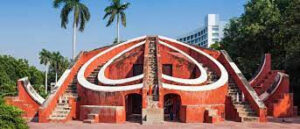
Introduction:
Jantar Mantar, a collection of architectural astronomical instruments, stands as a testament to India’s rich scientific heritage. Located in various cities across the country, these structures were built by Maharaja Jai Singh II of Jaipur in the 18th century. Jantar Mantar is a Sanskrit term that translates to “instrument for calculation,” and these observatories were designed to facilitate accurate astronomical observations and calculations. This essay aims to delve into the basic details of Jantar Mantar, exploring its historical significance, architectural brilliance, and the instruments it houses.
Historical Background:
Jantar Mantar finds its roots in the 18th century when Maharaja Jai Singh II, a keen astronomer and mathematician, sought to rectify the discrepancies in the existing astronomical tables. Dissatisfied with the available instruments, he embarked on the ambitious project of constructing observatories equipped with precise instruments for celestial observations. Between 1724 and 1730, Jai Singh II built five Jantar Mantar observatories in different cities, including Delhi, Jaipur, Ujjain, Mathura, and Varanasi.
The purpose of these observatories was to accurately measure time, predict eclipses, and study the positions and movements of celestial bodies. Jai Singh II’s quest for scientific precision and his fascination with astronomy culminated in these architectural marvels that continue to attract scholars, historians, and tourists to this day.
Architectural Brilliance:
Jantar Mantar stands out not only for its scientific significance but also for its architectural ingenuity. The observatories are characterized by large, masonry instruments that are both functional and aesthetically appealing. The structures are constructed using stone and marble, showcasing a blend of Mughal and Hindu architectural styles. The careful placement of each instrument reflects the meticulous planning and mathematical precision employed in their design.
One of the key features of Jantar Mantar is the alignment of its instruments with the cardinal directions. The observatories are laid out in a grid, emphasizing the importance of cardinal points in astronomical observations. The instruments themselves are large, geometric structures that capture the imagination with their intricate detailing and grandeur.
Instruments at Jantar Mantar:
Samrat Yantra (Supreme Instrument): This massive sundial is one of the most prominent instruments at Jantar Mantar. It can be used to measure time with remarkable accuracy, taking into account the declination of the sun throughout the year.
Jai Prakash Yantra (Instrument of Victory): Consisting of two hemispherical bowls, this instrument is designed for measuring the position of celestial bodies. The observer can align the instrument with the celestial object and determine its position.
Ram Yantra: Comprising two large cylindrical structures, Ram Yantra allows precise measurements of the altitude and azimuth of celestial objects.
Digamsha Yantra: This instrument is an equinoctial sundial used for measuring the azimuth and altitude of celestial objects. It consists of a large triangular structure with an embedded scale.
Nadivalaya Yantra: Designed for measuring the local time, Nadivalaya Yantra is a cylindrical instrument with a perforated plate. The observer can note the time by tracking the sun’s shadow on the plate.
Significance in Astronomy:
Jantar Mantar’s instruments were groundbreaking in their time, providing astronomers with unprecedented accuracy in observations. The precise measurements facilitated by these instruments were crucial for constructing more accurate astronomical tables, predicting celestial events, and advancing the understanding of the cosmos.
Jantar Mantar’s enduring significance in astronomy lies in its contribution to the study of celestial phenomena such as eclipses, equinoxes, and solstices. The observatories served as hubs for scholarly activities, fostering a scientific community dedicated to unraveling the mysteries of the universe.
Legacy and Preservation:
Despite the passage of centuries, Jantar Mantar continues to be a symbol of India’s scientific prowess. Recognizing its historical and cultural importance, several Jantar Mantar observatories have been designated as UNESCO World Heritage Sites. The efforts to preserve and maintain these structures involve a delicate balance between conservation and public engagement.
Preserving Jantar Mantar requires a multidisciplinary approach, involving archaeologists, historians, architects, and astronomers. Conservation efforts focus on maintaining the structural integrity of the instruments while ensuring that they remain accessible to the public for educational purposes.
Conclusion:
In conclusion, Jantar Mantar stands as a testament to India’s scientific heritage and the vision of Maharaja Jai Singh II. These observatories, with their monumental instruments and architectural brilliance, continue to captivate the imagination of astronomers, historians, and tourists alike. As a living heritage, Jantar Mantar invites us to explore the intersection of astronomy, mathematics, and artistry, providing a glimpse into a bygone era when scientific inquiry and cultural expression coexisted harmoniously. The legacy of Jantar Mantar endures, reminding us of the timeless quest for understanding the cosmos that transcends temporal and cultural boundaries.
—
Thanks,
with regards,
Mr. Raj Sharma (Director)
Garhwal Himalayan Expedition
{ App. by ministry of tourism }
Contact no. 9811275279
Whatsapp no. 9717237624
Office no. 011-47094166, 011-45458806
Travel Agency Address:-
B 2 / 263 1ST FLOOR, ROHINI SECTOR – 6 DELHI – 110085
